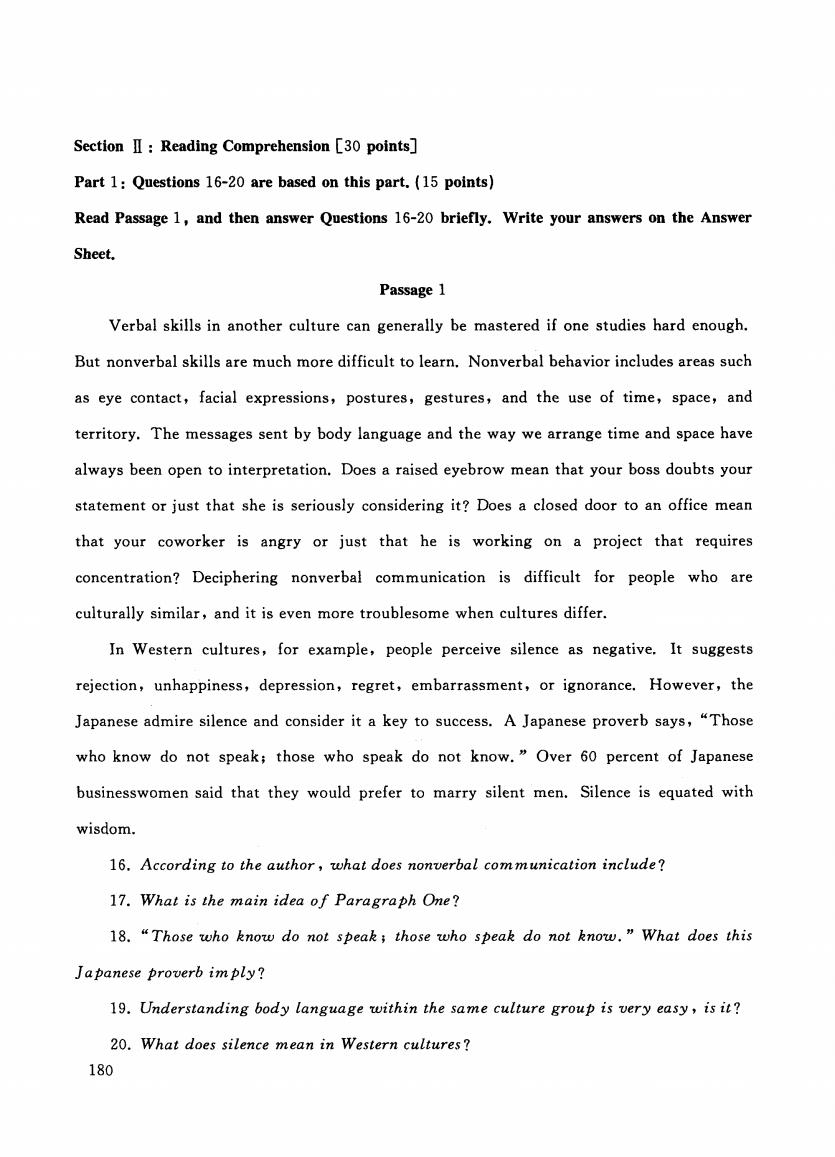正在加载图片...

Section II:Reading Comprehension [30 points] Part 1:Questions 16-20 are based on this part.(15 points) Read Passage 1,and then answer Questions 16-20 briefly.Write your answers on the Answer Sheet. Passage 1 Verbal skills in another culture can generally be mastered if one studies hard enough. But nonverbal skills are much more difficult to learn.Nonverbal behavior includes areas such as eye contact,facial expressions,postures,gestures,and the use of time,space,and territory.The messages sent by body language and the way we arrange time and space have always been open to interpretation.Does a raised eyebrow mean that your boss doubts your statement or just that she is seriously considering it?Does a closed door to an office mean that your coworker is angry or just that he is working on a project that requires concentration?Deciphering nonverbal communication is difficult for people who are culturally similar,and it is even more troublesome when cultures differ. In Western cultures,for example,people perceive silence as negative.It suggests rejection,unhappiness,depression,regret,embarrassment,or ignorance.However,the Japanese admire silence and consider it a key to success.A Japanese proverb says,"Those who know do not speak;those who speak do not know.Over 60 percent of Japanese businesswomen said that they would prefer to marry silent men.Silence is equated with wisdom. 16.According to the author,what does nonverbal communication include? 17.What is the main idea of Paragraph One? 18."Those who know do not speak;those who speak do not know.What does this Japanese proverb imply? 19.Understanding body language within the same culture group is very easy,is it? 20.What does silence mean in Western cultures? 180Section IT : Reading Comprehension [30 points] Part 1: Questions 16-20 are based on this part. (15 points) Read Passage 1 , and then answer Questions 16-20 briefly. Write your answers on the Answer Sh Passage 1 Verbal skills in another culture can generally be mastered if one studies hard enough. But nonverbal skills are much more difficult to learn. Nonverbal behavior includes areas such as eye contact , facial expressions, postures, gestures, and the use of time , space , and territory. The messages sent by body language and the way we arrange time and space have always been open to interpretation. Does a raised eyebrow mean that your boss doubts your statement or just that she is seriously considering it? Does a closed door to an office mean that your coworker is angry or just that he is working on a project that requires concentration? Deciphering nonverbal communication is difficult for people who are culturally similar , and it is even more troublesome when cultures differ. In Western cultures, for example , people perceive silence as negative. It suggests rejection , unhappiness, depression , regret , embarrassment , or ignorance. However, the Japanese admire silence and consider it a key to success. A Japanese proverb says, "Those who know do not speak; those who speak do not know." Over 60 percent of Japanese businesswomen said that they would prefer to marry silent men. Silence is equated with wisdom. 16. According to the author , what does nonverbal communication include? 17. What is the main idea of Paragraph One? 18. "Those who know do not those who speak do not know. " What does this Japanese proverb imply? 19. Understanding body language within the same culture group is very easy , is it? 20. What does silence mean in Western cultures? 180